#rise of the arthropods
Text
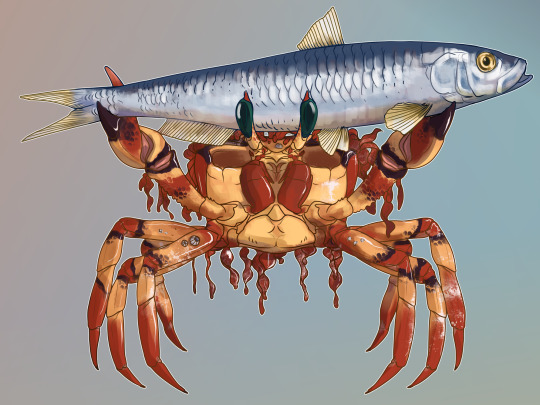
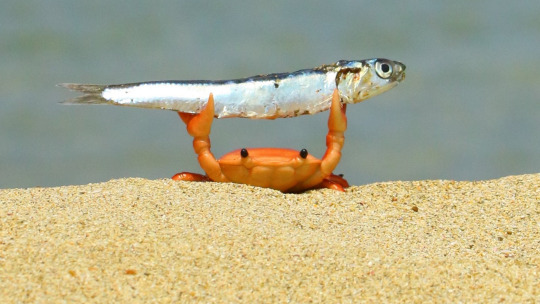
I have sinned. I was challenged (not really) and then I delivered. A person from FB had this idea and I was like "okay how about I just test this idea" and then it turned out better than most of my commissions.
Why am I like that!!!!
Anyway, don't worry, the sardine is okay and they were released back into the water soon afterwards.
24 notes
·
View notes
Text
It's crazy to me that "vertebrate/invertebrate" is a binary when "invertebrate" encompasses so many different things. Why can't the spineless creatures get a shot
#thinking on some kind of fantasy world where the arthropods rise and get huge and mollusks diversify like bugs#i know it'd be very freaky but very cool and fun
2 notes
·
View notes
Text
Happy New Year!
Let's imagine it was the Earth itself that was going into its 2024th year. That is to say, we're compressing the entire history of the Earth into just the past 2023 years. What events would have happened when?
Well, not too much is certain about the first couple decades after our planet formed, until around 50 CE when we were hit by another proto-planet, Theia, and the debris formed the Moon. After a couple years of the planet cooling down again, the oceans formed out of boiling rain. The timing of the origin of life is very uncertain, but there are chemical signs it may very well have happened as early as the second century. Around 200 CE, the gas giants did a big funky orbit-swapping dance, and in the process inflicted the Late Heavy Bombardment on the rest of the solar system, meaning the Earth was suffering a ton of meteorite strikes for the entire third century.
The first indisputable evidence of life is from around 330, and the first stromatolites appear around 470. Those are basically the first fossils, stones created by layer upon layer of oxygen-producing cyanobacteria living and dying on top of one another. But even with oxygen producers evolving, it would take many centuries before oxygen became a major part of the atmosphere: not until the Great Oxygenation Event, which happened during the ninth and tenth centuries. That's also about the time the first complex, eukaryotic cells evolved through a symbiosis between an anaerobic archaean and an oxygen-breathing bacterium. The bacterium became more and more focused on just the oxygen-breathing task inside the larger cell, until its descendants were mitochondria, which as you all know are the powerhouse of the cell. The next seven centuries passed by with only slow, gradual changes, and life continuing to be unicellular and difficult to find in the fossil record.

(1735's Snowball Earth, by me)
From 1704 to 1730, the entire planet froze over. After merely two years of thaw, it happened again, this time lasting from 1732 to 1742. But these snowball Earth episodes set the stage for the evolution of animals that began right after. Across the mid-18th century, the bizarre Ediacaran biota, with its strange symmetries, fronds, and fractal-like pattern filled the oceans. In the early 1780s they went extinct, possibly due to a temporary drop in oxygen-levels, only to be replaced by a great variety of quite different creatures in the Cambrian Explosion.
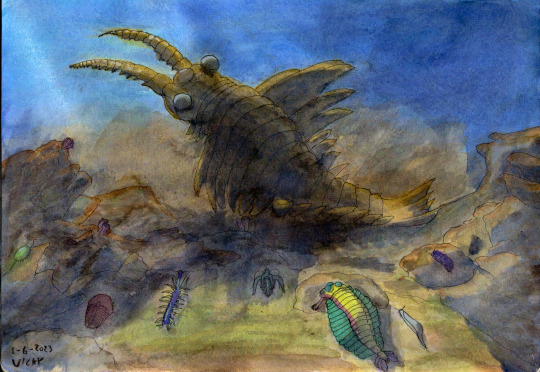
(Class of 1799, by me)
Starting in 1784 and running for a few decades, the Cambrian period saw the origin of most of the modern animal phyla, reaching its most famous form in the Burgess Shale fauna of 1799. During this time, most animals still lived on the sea floor, either attached or crawling, with relatively few actually swimming creatures. Plants started tentatively moving onto land around 1817, and in 1825, the rising of the great Appalachian mountains caused a severe drop in global CO2 and thus temperatures, leading to the Late Ordovician mass extinction.

(Horseshoe crabs and sea scorpions on a beach in 1834, by me)
Bony fish first showed up during the 1830s, and around the same time plants were getting serious about inhabiting the land, evolving roots and vascular tissues so they could properly grow there. Millipedes and the ancestors of spiders were the first animals to follow them onto land. Our own fishy ancestors did not take their first step until 1857, by which point the arthropods were well established there and the plants had figured out how to become trees. The Late Devonian extinction, partially caused by the evolution of said trees and partially by the south pole freezing, played out in two pulses over the late 1850s and early 1860s.
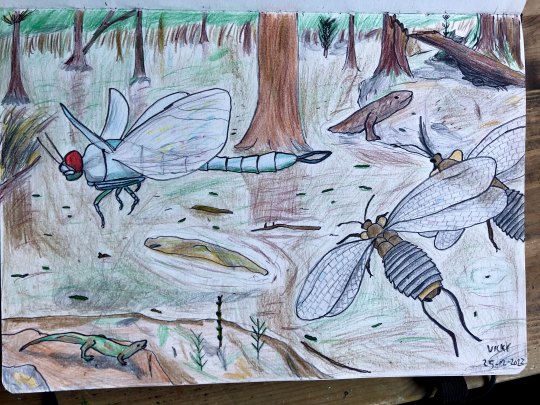
(Swamp prominently featuring Meganeura and Mazothairos in 1889, by me)
Arthropods and vertebrates continued to gain adaptations to life on land. The insects became the first creatures ever to fly in 1878, and the high-oxygen atmosphere of the time would be especially good to them. Around 1884, a group of vertebrates called the amniotes, after the membrane that kept water inside their eggs so they could lay them on land without them drying out, split into two groups: the reptiles and the synapsids (which we mammals descend from). The next few decades would see the synapsids in particular being extremely successful as the supercontinent Pangaea formed. Until 1912, when a massive episode of volcanism caused the worst mass extinction of all time, the Great Dying, scouring the Earth of a huge portion of its life.
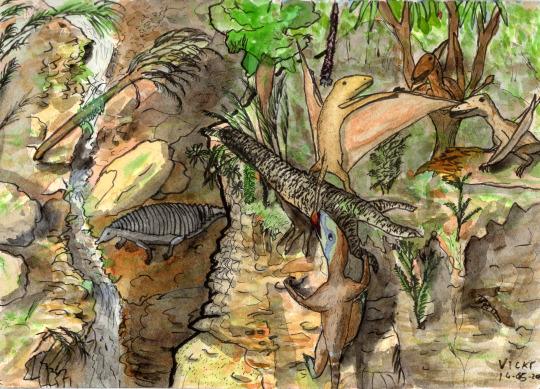
(A 1930 scene featuring the three branches of archosaur: dinosaur, pterosaur, and pseudosuchian, by me)
The 1910s were a period of slow recovery during which strange new forms of animal evolved. Many different, unrelated reptiles, such as the ichtyosaurs and plesiosaurs, went to sea, where they would continue to provide some of the most impressive creatures for most of the 20th century. On land, the dinosaurs first appeared in 1920, though for the next decade or so they'd live in the shadow of their pseudosuchian (crocodile-line) cousins. In 1934, Pangaea began to break up, resulting in another terrible pulse of volcanism that caused a lot of extinctions and left particularly the feathered and furry survivors with a lot of empty niches to fill, allowing the dinosaurs and mammals to diversify greatly. The last common ancestor of all modern mammals lived in the early 1940s, and by 1957 the dinosaurs had figured out flight, with Archaeopteryx usually being considered the first bird. Other dinosaurs took on an incredible variety of sizes, shapes, and forms. Some of the most famous ones include Dilophosaurus (1942), Diplodocus and Stegosaurus (1955), Iguanodon (1969), Velociraptor (1991), and Tyrannosaurus rex (1994).

(A tropical lakeside in the year 2000, by me)
In 1995, the world was struck by a meteorite, wiping out many groups, including the marine reptiles, pterosaurs, and ammonites. The surviving mammals and dinosaurs went on to diversify across the next couple of years and had formed thriving new ecosystems in the tropical world of the turn of the millennium. The first known bat lived in 2001, and the whales returned to the oceans next year. Around 2009, the world's climates turned colder and dryer. Antarctica froze over and grasslands spread widely. Our last common ancestor with the chimpanzees and bonobos lived in 2021, and by new year 2023, our ancestors were getting brainier and more proficient with tools. That's also when the north pole froze and the Quaternary ice age cycle began. The first known members of Homo sapiens lived on 10 November 2023. The latest ice age started on 14 December, and ended at 2 AM on 30 December. The great pyramid of Giza was built at 6 AM on 31 December and On The Origin Of Species was published at 23:22 PM.
#palaeoblr#happy new year#2024#geologic timescale#vicky's vritings#one year is 2.244 million years if you're curious#and yes i did exclude both year 0 and 2024#since 0 doesn't exist and 2024 hasn't happened yet#my art#i rather enjoy having an extensive collection of my art to illustrate my paleorambles nowadays#incidentally the big bang occurred in 4121 bce at this scale#which is curiously close to the date of creation creationists made up#if only they would follow through and insist humanity itself was seven weeks old too
124 notes
·
View notes
Text
on the planet of serpent cults, where heat lightning always flickers on the far horizon, the queen of swords roams.
a thief, a reaver, a slayer: she is all these things and more. she embraces danger like a lover, and makes a fool of fate. she knows the five secret ways into the cursed temple, where one false move means death. she does battle with skeleton warriors while the stormclouds gather and the rising wind whips the tresses of her hair, which is black as grief or bright as gold—whatever works best for you.
1929, 1932, 1939—the year of publication is irrelevant; the queen of swords is always in her prime, and never grows old or infirm. if she dies, she will die by the sword, and that will never happen as long as she has an audience, and on the planet of jungles and ziggurats the golden age of pulps never ends. she is often wounded, but there is always a hut with dried herbs hanging from the rafters and a kindhearted peasant daughter to nurse her back to health, until the wound is just another scar.
she has so many scars.
she wears a bikini of bronze scales, which is the expected outfit for a woman in her line of work, but she would have worn it even if it wasn't, because she enjoys showing off. her body is muscular and sword-marked. her girlbulge is considerable. her pupils are dilated and her teeth stained red from chewing a root she got in the silver city, where every building is a generations-old repurposed spacecraft, and all the inhabitants are telepathic, and drugs grow freely in every garden. the root improves her reflexes as well as having an aphrodisiac effect, which is a useful combination on the planet of tombs and warlords, where lascivious sorceresses lurk behind every corner.
(when she was just a boy, her entire village was put to the sword. now she scatters deathblows the way a sower scatters seeds, and plumes of blood sprout in her wake. there is nothing wrong or unhealthy about this. it's the natural order of things, on the planet of conquest and savagery.)
the queen of swords, who dances on the razor's edge, who flouts the laws of men and gods! the horse she rides is always rearing; she is always backlit by lightning; her cloak snaps in the boreal gale. vallejo, frazetta, norem—everyone who is anyone has painted her. her name is whispered in the city of knives, where thieves hide in every cellar and hounds of bone and black smoke stalk the roofs, and in the city of sails, and in the city of broken idols. they speak of her even in the city of jeweled thrones, the greatest of all the cities of men, where sleep martyrs take stimulants that keep them awake until it kills them, and sarong-clad princesses burn for her touch.
though she has visited a thousand cities, she has no home. though she has taken a thousand lovers, she has never married. she lies awake late into the night, turning her melancholies this way and that like puzzle boxes.
on the planet of dust storms and pterosaurs, where every swamp teems with lizard-men and eight-foot-tall arthropodal reavers from beyond the stars descend in dropships made of steel and crystallized honeydew, there is always another adventure. but afterwards, in the silence after the clash of steel, she leaves empty-handed. the jewels slip between her fingers, and when her latest woman asks her to stay, of course she cannot accept. there is always another adventure, another forgotten dungeon or distant beckoning city, and as long as she has an audience, the queen of swords must roam.
yes, hers is a lonely life, but look, look: as she trudges through the violet sands of the southern wastes, drops of rain begin to fall, fat and blood-warm, stirring the hot dust—and the desert blooms around her.
60 notes
·
View notes
Text


A recurring adaptation among limbed animals are the specialization of limbs away from their original purpose of locomotion: on HP-02017 most prominently the bipedalism of the jerryboas that would give rise to many biped clades, such as the walkabies, rhinocheirids, podotheres and pterodents, to name the most notable examples, their forelimbs no longer taking part in walking and instead finding other uses for grasping, fighting and even flying.
Yet this trait becomes even more evident in animals with more that four limbs, as is the case with many insects, crustaceans and other arthropods that have made unusual uses of their front legs, such as pincers and grabbing claws. And thus, while vertebrates are limited to a maximum of four legs, this effect has been most pronounced in the one clade that bypassed this anatomical constraint: the sixteen-pseudolimbed daggoths.
The barrelbacked rumptusk (Abyssoscrofa nychoceros) is a daggoth species related to a more basal group of the biblarodons, and is a relatively small species: being about five or six kilograms on average. While possessing sixteen pseudo-limbs, each in fact a very modified finger emerging from its "shoulders" and "hips" (actually its ankles and wrists), only six are used in walking: moving with a distinctive shuffling tripod gait that moves the front and hind legs of one side and the middle leg of the other at once, ensuring that a minimum of three legs are always on the ground at any given time, granting it good stability on the slippery rock floors of the cavern system.
The ten other digits, on the other hand, have found unusual new uses in this peculiar species. Like with many other daggoths, the first and last pairs have evolved into long feelers equipped with bristly sensory hairs to feel its way through the lightless caves. But the second and second-to-last pairs are far thicker and enlarged, and possess large upward-curved claws: which it uses to defend against its main predators, the carnivorous blindmutts, and also used by males when they compete over territory and mates. Armed both front and back, the claws function much like horns and tusks in fending off an enemy: with the advantage of actually being moveable and able to point in the direction of an attacker.
These small, stout creatures are omnivores, and indiscriminately eat whatever edible thing they can find: shroomors, meatmoss, mocklichens, fungi, bacterial mats, invertebrates and even smaller daggoths are all items on the rumptusks' menu. Its nasal tendrils are short, broad and flattened, allowing it to root about in the abyssal foliage in search of food, while its third pair of forelimb digits bear smaller, yet still enlarged claws that in contrary to its main claw-horns curve downwards, which it uses to dig for its favorite food: the swollen, rhizome-like mycelia of mocklichens, excavating it from the rocks and organic mulch that gathers at the floors of the caves.
-------
87 notes
·
View notes
Text

Silurian seas | Oceanos Silurianos
🇬🇧
The Silurian Period also marked a critical phase in Earth's history with significant developments in marine life. During this period, marine environments witnessed the diversification of invertebrates, including prominent groups like brachiopods and trilobites. Jawed fish, both cartilaginous and bony, emerged and began to dominate marine ecosystems. Graptolites, cephalopods such as nautiloids, and reef-building organisms like corals were prevalent. Sea scorpions (eurypterids) were notable marine arthropods.
The Silurian experienced global sea level changes, influencing the distribution and diversity of marine life. These marine ecosystems set the stage for further evolutionary events, laying the groundwork for the subsequent Devonian Period and the rise of more complex marine life forms.
🇧🇷
O Período Siluriano também marcou uma fase crucial na história da Terra com desenvolvimentos significativos na vida marinha. Durante esse período, os ambientes marinhos testemunharam a diversificação de invertebrados, incluindo grupos proeminentes como braquiópodes e trilobitas. Peixes com mandíbulas, tanto cartilaginosos quanto ósseos, emergiram e começaram a dominar os ecossistemas marinhos. Graptólitos, cefalópodes como nautiloides, e organismos construtores de recifes como corais eram prevalentes. Escorpiões-do-mar (euripterídeos) eram artrópodes marinhos notáveis.
O Siluriano experimentou mudanças globais nos níveis do mar, influenciando a distribuição e diversidade da vida marinha. Esses ecossistemas marinhos prepararam o terreno para eventos evolutivos subsequentes, estabelecendo as bases para o período Devoniano e o surgimento de formas de vida marinhas mais complexas.
#science#paleontology#geology#paleobotany#universe#biology#earth#digital painting#space#artwork#silurian period#paleozóico#paleobotânica#paleozoic#paleontologia#paleoart#arte digital#original art#artists on tumblr#art#digital art#my art#sea#ocean#marine biology#marine life
25 notes
·
View notes
Text
Forgotten Lives 3 Lore Dump
Just a bunch of lore related observations from FL3
Framing Narration (Fourth Doctor/T Baker POV)
Mindbending was not invented by the Time Lords but by an arthropod species with ‘umpteen’ lives.
The Master was better at it than the Doctor at the Academy
George Gallaccio
The Lungs of the Birastrop is two years after Doctor Crocus and the Pages of Fear on Earth
The TARDIS is still a police box
The Birastrop are part of the Cult of Morbius, they do not believe in the Elixir of Life
The Doctor claims he used to be a friend of Morbius, but he seems to be bluffing
Varne can fly the TARDIS
The Doctor believes he made the firecrackers that caused the events of this story
Varne departs and a new companion, Agnes, joins in this story.
The Time Lords have been directing this incarnations efforts from the shadows, he is already considered a renegade by this point.
The firecrackers were actually made by a group of Time Lords on their final incarnations (Led by Sorianius) who had swallowed Deathworm Morphants to merge with the gunpowder.
The Doctor believes he may have killed Morbius
Framing Narration cont.
The Morbius Monster’s lungs are that of a Birastrop
The Doctor was unaware of these lives by this point, though they didn’t seem to be “erased”, merely forgotten.
Robert Holmes
The Doctor put in a healing tank frequently
He seems unfamiliar with this incarnation, and the clothes, but he also clearly has amnesia from being pulled out of the tank. (This is due to him coming out of his infiltrator persona)
By the time he reaches the hall, he’s settled in to his persona again.
His most recent mission prevented ‘a big old civil war’ and dismantled the war machine of ‘a recently deposed President’ (Morbius).
The Morbius civil war occurred during this Doctor’s era
He infiltrated the enemy side as “Bretor Ohm”, this was a new body but not a new incarnation. (Chameleon Arch?)
His failure in his final mission is responsible for Morbius’s escape (In actuality, Sellin used a vocal command to halt him)
Morbius was of House Aurora
Sellin had also given the real Bretor Ohm the Doctor’s biodata as a backup plan, but he escaped and captured Morbius whilst the real Doctor distracted Sellin.
Ohm and the Doctor ended up escaping in a TARDIS (But he was presumably later recaptured)
Framing Narration cont.
Upon reaching Holmes, Morbius realises that the Doctor is an active enemy of his, he redoubles his efforts to push the Doctor back after this point.
Graeme Harper
This Doctor has not been home in a very long time.
Morbius’s was in power during this Doctor’s era. That is why they ran away.
This Doctor has ‘raised families’
Alexandra Justine Collins is travelling with the Doctor
This incarnation disappeared into the Portal of Transformation after contemplating returning to Gallifrey. It is unclear if this is intended to be the cause of this incarnation’s rejuvenation.
Framing Narration cont.
This incarnation was secretive enough that the echo of their persona was still deflecting secrets from Morbius’s intrusion during the mindbending battle years earlier.
The Camfield incarnation horrifically lost his family (Cold Fusion) and the Fourth Doctor is still able to feel the pain even with centuries of distance.
Douglas Camfield
Another companion, Carol Williams. Stowed away on the TARDIS.
After the Loomborn revolt, the Camfield Doctor was forced into hiding.
He has left Dattany for a little while so he could heal from his family’s deaths.
The Doctor and Tallis (Someone who worked for him back on Gallifrey) believe some of his family has escaped the massacre. They go to investigate.
Morbius’s rise to power was occurring during this Doctor’s era.
Cedric and Jilly are still alive on Earth so were not related to the children killed in the Loomborn revolt.
Phillip Hinchcliffe
This Doctor parted ways with Rue eventually and settled down on Earth (Paris 1792).
It had been either 4 or -156 years since then depending on the perspective.
The Order of the Spheres and Time Lords eventually fell out, the Doctor’s handlers and the Unity were different groups.
After settling down on Earth, the Time Lords are still trying to find him. The Sisterhood of Karn uses this to blackmail him to take Françoise to Karn.
Françoise (Swan) becomes a new companion in a stripped down timeship (The Exedra) headed for Karn.
He is being pursued by another renegade called ‘The Citizen’, he wants the Elixir of Life from Karn. The Doctor leaves him to the mercy of the locals on Durcrow
The leader of the sisterhood is O’Hercha.
The Sisterhood has seen the Doctor prior to this.
The Time Lords regain contact with him in this story and intend to bring him ‘back into the fold’.
Framing Narration cont.
Four figures out the Sisterhood owes him a favour after recalling the Hinchcliffe Doctor’s life.
Christopher Baker
Cedric and Jilly’s mother is no longer ‘here’ anymore
She was Joan Smith (Miss Weston). Joan Weston is the “Joan Redfern” that Baker fell in love with. He want by ‘John Smith’ for this time period.
They first landed in early 1938 after Banks-Stewart’s renewal.
The Advisor is working alongside the Unity to disrupt Earth history. He is currently operating as a scientific advisor for the ‘Radio Men’ (Cybermen?)
The Doctor has been ‘playing with his biology’
Jill Smith (Jilly) was born in 1939
Joan Smith eventually died
Robert Banks Stewart
Joan and The Doctor have been associated for four years, it is now 1944, this means he has been on Earth for six years (1938-1944).
The Doctor’s talking owl has no name because ‘birds don’t use names’
The Magus is working with the Nazis.
The Magus had two twins working for him but one perished at the Temple of Gog and Magog.
A sample of the Elixir of Life found its way to a safe in Ireland.
The Magus claims he wants the Elixir of Life to ensure Hitler stands trial for his actions. This is a lie, as he was wounded and is dying.
Maggie O’Hecha stole the Elixir before the Doctor or Magus could get to it, she would later become leader of the sisterhood.
The Sisterhood sent the Doctor to 1945 and he saw and crystallised the end of the War.
Joan Weston’s real name isn’t Joan Weston (Joan Redfern??). In 1944 she and the Doctor left Earth to travel.
Christopher Barry
Morbius was friends with the Doctor according to ‘the story’.
His wife will slap him next time she sees him and hole up in a ‘Tower in Avalon’.
Framing Narration conc.
Morbius had known Christopher Barry’s Doctor, he’d attempted to harness the living story in order to fulfil his future dreams.
The living story had indeed raised Morbius to greatness only to bring him low in the end. He only learns this upon hitting Barry’s memories in the mindbending match, and this is why he goes full rage afterwards.
Four is unsure how many of these reawakened memories he’d retain, but doesn’t care as he embraces being an ever evolving story.
#dweu#doctor who#doctor who eu#forgotten lives#pre-hartnell#morbius doctors#obverse books#fl3#the brain of morbius#fourth doctor
18 notes
·
View notes
Note
I saw your tags on the mycology tumblr post - I challenge you to scare me with a mushroom fact. I’ve harvested and eaten wild mushrooms a few times, I’ve got my share of guidebooks and worked on research my university did on suede boletes. I’m no spring chicken of the woods but i’m also far from an expert. Scare me with the Deep Mushroom Lore
Woaaaah this got a bit lost and im a bit late, yikes! Anyway it looks like you were focusing on the Basidiomycota phylum which is where a lot of the frontliners and popular ones are. But let's look at the Ascomycota, lots of scary stuff there, lord there's so much but baseline ig is cordyceps which everyone knows about now. They can alter and control insects, a big example is bullet ant behavior to makes them climb as high as they can and bite onto the grass or whatnot to secure themselves until the host dies. They go as high as possible so when the cordycep actually grows the fruitbody the spores can spread as far as possible. Luckily for us human nervous systems are way too complex for the cordyceps....for now.

I mean any parasite that controls it's host is crazy and I 10000% recommend looking into it.
There's another fungus Laboulbeniomycetes that grows exclusively on arthropod exoskeleton.
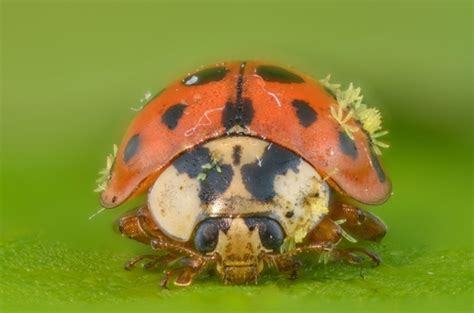
A lot of fungal diseases make me shudder, there are probably fungal spores in your lungs right now! Pneumocystis is the genus of a yeast that loves your lungs and you guessed it, causes a strain of pneumonia that's very hard to diagnose! Yippee! Mostly because it is very hard to culture.
Let's look at everyone's favorite yeast Conidida. This guy is DIMORPHIC so it can be a yeast or invasive hyphae depending on environmental triggers/conditions, and wouldn't you know it, lives at human body temp. This guy causes yeast infections and the like.
Aspergillus is one that ferments soy products BUT can also cause Apergillosis which can cause an allergic reaction and eventually a fungal ball growth in your lungs, aak!
In a different phylum, Mucoromycota, Mucormycosis is probably my least favorite as the group USUALLY targets your fruits and is that pesky mold. Well another version of it will target the sinuses of immunocompromized diabetics. These are sugar loving molds so uhhhhh, no bueno. I recommend looking at pictures with CAUTION it is gross. The eyes can get really messed up, black lesions can show up on your face really really nasty stuff.
Anyway, Ascomycota cool group, lots of human diseases (many of which are hard to cure because of how close fungi are to animals so we target very specific things in their cells but OOPS resistance is on the rise), have fun with this info ::)
#mycology#ascomycota really popped off on the diseases#ollie rambles#<<<yea no i RAMBLED#but yea apologies for how late this is been reaaaally busy#long post#call me patient zero the way fungi have consumed my mind
23 notes
·
View notes
Text
Vermin (work in progress)
I.
My body is a rotten animal. My bicycle is left under the water. I haven't got to understand myself yet and I still came here to kill. I can pass through surfaces easily as my self is a semi-transparent layer. Dead water air and the stagnant sea. There was some paint on these hands when i found them.
The air is all saturated with smoke. I know you can see me when you look out your window. It doesn't really mean anything. Like peat soil, I'm standing in the way of the road. Cars look at me. And I forget what I'm supposed to do. Weren't you like this when you were still in your body? Some alcohol would change you, I can feel in this stomach now the way that you were. Your phone got destroyed in the water so there's no one else for now. The earth will tilt beneath us when I get sober. So you recover me. I found myself in dreams like you. The fallen trees in the forest that were incapable of decay. It's too late. The trees were all turned into ash, a fine white powder, while those grotesque tessellations of smoke replace their plumage.
The city used to be surrounded with trees. It was a part of the world. I don't know what these words still mean when I remember them. You take control at times I get too calm to follow death. Attached together, we're everything attached together. I can't really understand what you want except that missing a thumb like this is spiraling.
Your body is inconvenient. I went to your apartment when I found you and I pulled apart your strange collections. It seems you were in love, from the way that you didn't live in your room for a while. The plant there was dying. Its vines were all turning blond and brackish strands of hair, like pitiful handfuls can be clutched from a scalp. Your life was getting dismal with love.
I think that I came here to kill someone. There's signal interference. The pistol you kept in the closet, I took that out the first night and we walked around the city together. You start to understand yourself when it's losing connection. I was still damp from the fall. Still walking around there wrenched and bloody. You don't look them in the eye when there is smoke coming out of your clothes. Black smoke fills the sky at night and it turns back to white and red in the morning.
I keep walking home to your hole in the floor. The place you were disappearing. You're gone now, except those chemical reactions and you occasionally wake in the night. I need to keep drinking so I can stay in control of this terrible dream. You look at the ceiling or into the mess of green skeletons outside and keep thinking it won't be like this forever.
And everyone knows it's too late for pollution. You may as well eat the pigeons off the street. You may as well eat the rats and arthropods before the water rises. There's someone at the door. The window is broken so it's very cold in here. We talk in the surface of water that your face reflects and you try to explain yourself sometimes. I told you that we're going to kill. It doesn't seem to bother you much. It's just okay that we are going to kill someone. The world got to be like that while you were alive.
A clot of hair in the drain, that's how I describe it. I need to be inebriated to float back on the surface. The scraps of dead souls that can molder together. Spaces between, congealed tension and reconstitution. You understand it if you don't. No one thing or another. Those particles of smoke who pulled you out of the water when you died. It's not as simple as that. There isn't death.
You walk around with the body when I can't get numb anymore. He was at the grocery store again and it felt like falling under the water. The hammer from the wind that dragged you off the bridge. It was the grating in the middle that felt treacherous before. You get used to some things and then they kill you. I can't hate you like you wanted me to, and you can never want to be in love with me.
15 notes
·
View notes
Text
Why Aliens Abduct Cows
Mammals are rare among the stars. It was a meteorite that hit Earth 65 million years ago, wiping out the reign of reptiles, that allowed mammals to flourish here. And that eventually lead to the rise of human civilization. Most planets didn't have that luxury. They are ruled by some manner of amphibious or reptilian species. And there are plenty of bugs too.
This has made milk somewhat of an interstellar delicacy. Not the kind made from plants, but true honest milk animals use to nurse their young. When alien life first discovered Earth, they were amazed at how casually we consumed this scarce treasure. This white gold.
The first abductions were discreet. It was bad form to steal from lesser civilizations. Poachers would drive by, snag their own personal milk factories, and jet off before anyone noticed.
But no secret is kept forever. And the universe was desperate. They craved milk more than anything. Eventually the mask slipped. A species of bee-like arthropods, renowned for their industrial efficiency, was given official jurisdiction over Earth. All this had happened before humanity ever knew of life beyond the blue marble.
Earth's new owners saw fit to announce their presence by abducting animals en masse. They studied Earth's life, seeing which animals were capable of producing milk and discarding the rest. Soon they were bottling and selling milk of every variety. Cow, goat, cat, ferret, anything you could imagine.
Of course, humans are mammals too. This fact was not lost on the thirsty masses. They had wiped out all of the planet's defenses as soon as they arrived, and had no reservations about scooping humanity up along with their animal companions. Billions of women were pumped daily. Given hormones to increase their breast size and production rate. Broken and brainwashed until few could even remember their own names. Some of the men were turned into breeders. Some saw work as farmhands. Most became food.
It didn't matter that humans were intelligent. It didn't matter that they had a civilization, a culture. Their only impact on the universe would be the milk they provided. They were no different from the animals pumped alongside them.
10 notes
·
View notes
Text

Inzector
The arthropods shall rise!
Source
Creator: DeviantArtistMax
#lego#bionicle#animal#animal shape#monster#monstrosity#insect#insectoid#mantis#mantid#armor#armor plates#natural armor#carapace#humanoid#humanoid insect#pincers#multiple limbs#multiple legs#horns
18 notes
·
View notes
Text
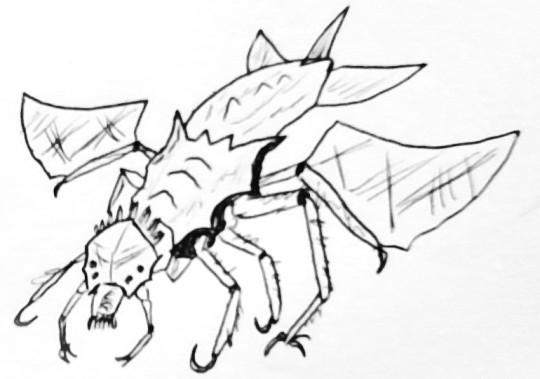
This one is only a small monster, but it's always nice to have more arthropods.
-
MARUN-KADAKI
Title - Symbiont spider
Monster class - Temnoceran
Known locales - Direct proximity to Ojoz-Kadaki, either underwater or isolated islets
Element/Ailment - Water + Bubble
Elemental weakness - Ice (3), Dragon (2), Thunder (2), Fire (1), Water (0)
Ailment weakness - Blast (3), Poison (2), Paralysis (2), Sleep (1), Stun (1)
Marun-Kadaki is a temnoceran and a small monster, residing in the deepest depths in the ocean where it gathers with its fellows upon the back of the gargantuan Ojoz-Kadaki. These temnocerans are only seen when Ojoz-Kadaki migrates to the surface, scuttling across the giant's back, cleaning it of any parasites or other discomforting organisms in the joints or underside. They were well adapted to their symbiotic role, with their mouthparts forming a toothy nozzle that vacuums up tiny plants and creatures whilst the pedipalps and hooked first and second limbs dislodge clinging parasites. The third pair of limbs handle clinging to Ojoz-Kadaki, whilst the fourth pair of limbs, alongside the finned abdomen, help the temnoceran swim should it need to find another host.
Marun-Kadaki is a humble omnivore, feasting on unwanted guests on the small community that forms on Ojoz-Kadaki's back. Cleaning the giant of algal overgrowth and parasites, it forms a team with several other Marun-Kadaki, ensuring the health of their host is maintained by their cleaning. The size difference is staggering; Marun-Kadaki is half the size of the average human whilst Ojoz-Kadaki.
Though small, Marun-Kadaki can still be dangerous to humans in the rare circumstances when they meet. As the Guild only encounters Ojoz-Kadaki during its rise to the surface and must sends hunters to slay or repel the giant before its ability to influence weather disrupts ecosystems, Marun-Kadaki perceives the hunters as a threat and fights to protect the host. Lacking the sheer size and power, they instead focus on distracting and restraining tactics, often leaping onto a hunter and hooking their limbs into them in an attempt to hold them still and make them easier targets for Ojoz-Kadaki. Their nozzle-like mouthparts also spew a foamy blast of water that replicates the bubbleblight used by the leviathan Mizutsune.
Researchers now know that the relationship between these temnocerans is more than mutualism in itself; they are actually the dimorphic male and female of the same species. Ojoz-Kadaki, the gargantuan female, is the lynchphin for survival for the comparatively miniscule male Marun-Kadaki. They depend on the communities formed upon her back for food and shelter, and she in turn depends on their care to overgrowth of unwanted symbionts. Another obvious benefit to this co-dependant lifestyle is that Ojoz-Kadaki never has to venture in search of a mate. When she is ready to lay eggs, she already has a group of males on hand to ensure reproduction.
In itself, a Marun-Kadaki is little threat even to novice hunters. However, as they are only found in proximity to Ojoz-Kadaki, only the most experienced of high/master rank hunters ought to encounter them when they confront the gargantuan females. Hunters must be aware that while Marun-Kadaki is rather fragile, their ability to attack in groups and endeavour to distract hunters from the immediate danger of the giant female can be lethal. Endeavour to slay any Marun-Kadaki as quickly as possible before they enable Ojoz-Kadaki's more predictable attacks.
-
Thank you for reading and take care.
7 notes
·
View notes
Text
ranty personal talk or wtv, no trigger warnings besides maybe insects but just talking yk :)
I think the funniest part about human life is how much the little details can affect something.
I like what I do now yes, both for my job and what I've dedicated most of my life to studying for in school or otherwise.
I do tech stuff for game design for clarification, but i wanted to study entomology.
Do zoology for insects and stuff simply because I loved bugs as a kid y'know? Yet was never able to truly do those things. As unlike tech, entomology, surprisingly, wasn't really rising to popularity anytime soon. Or at least to the rates at which technology was? Leading to most schools in my area just completely removing the option altogether, literally way before I was born.
And yeah while I do love designing video games and making art, I wonder what would've been different if given the options I wasn't given before sometimes.
I study insects for different reasons now, as I incorporate them into my art and games as characters or background inspirations. Create things with them in mind sometimes. But it isn't really solely focused on the insects themselves, moreso the idea of them.
I have a love for arthropods yet its almost always going to be something long distanced. As without certification or experience, my chances are pretty low for a genuine job. So for now I do my best efforts to just find peace in studying them from afar.
Ironically, I've taken marine science classes as they were the closest to genuine entomology classes. But not fully? They were in the same families as some insects or arachnids but not exactly full bug study.
But I mean hey, I probably would've never gotten into the electric guitar without the help of tech and gaming so that worked out. Love doing that honestly lmao
I think my longest obsession was insects though, have always liked them or drew them in art classes or just in my freetime.
Idk maybe people like them as much as I do so I'll post some of the ones I still have :D (they're pretty old now though sorry)
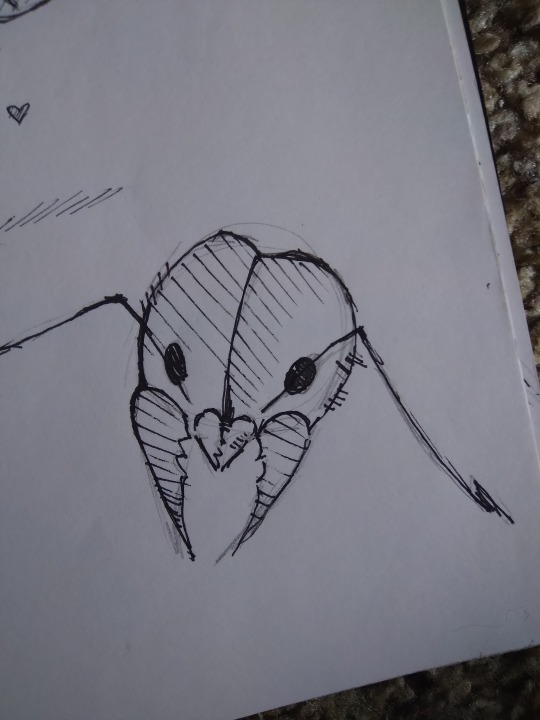
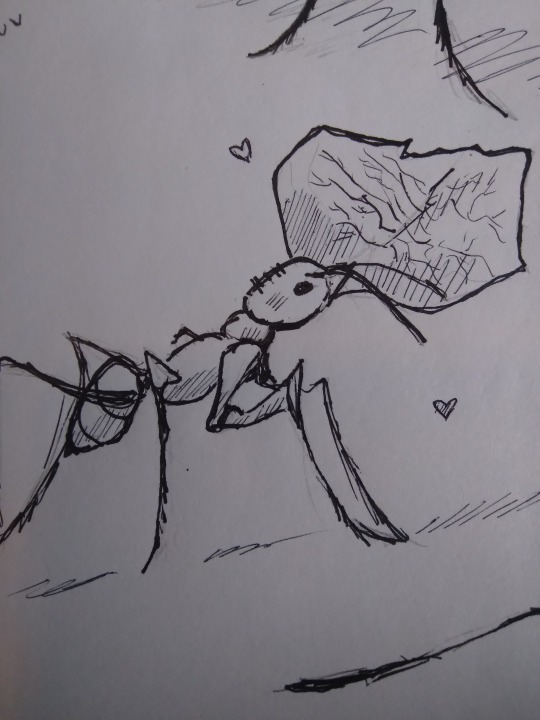
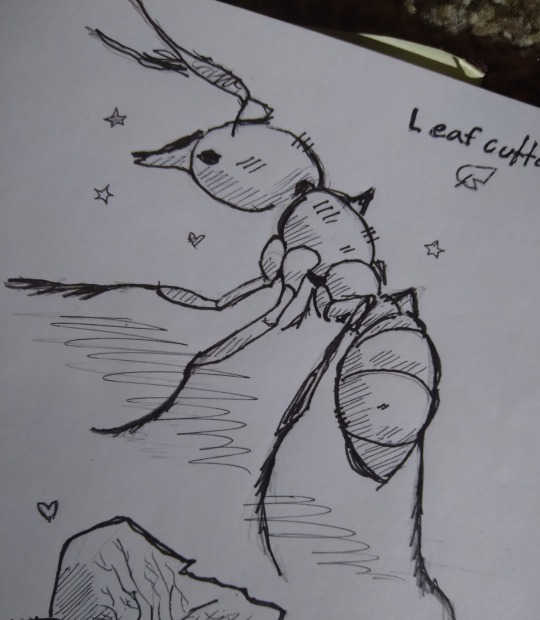

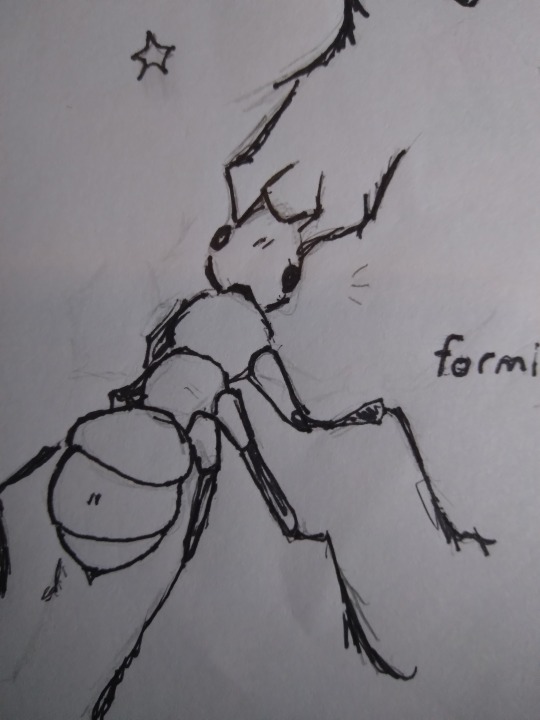
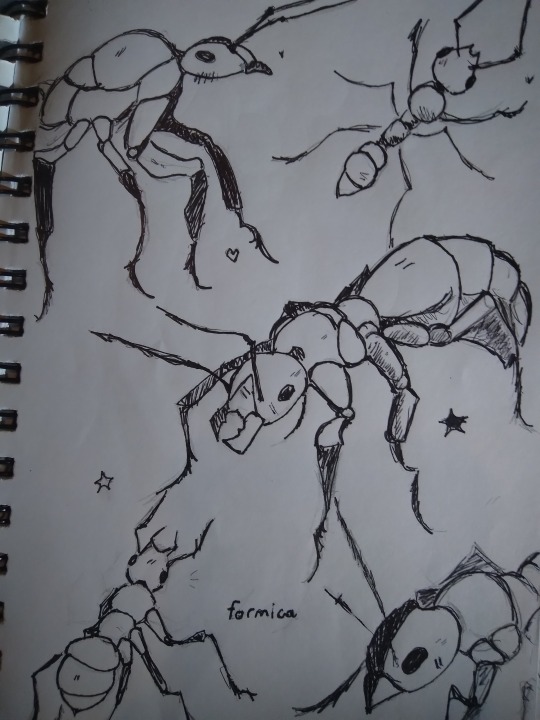

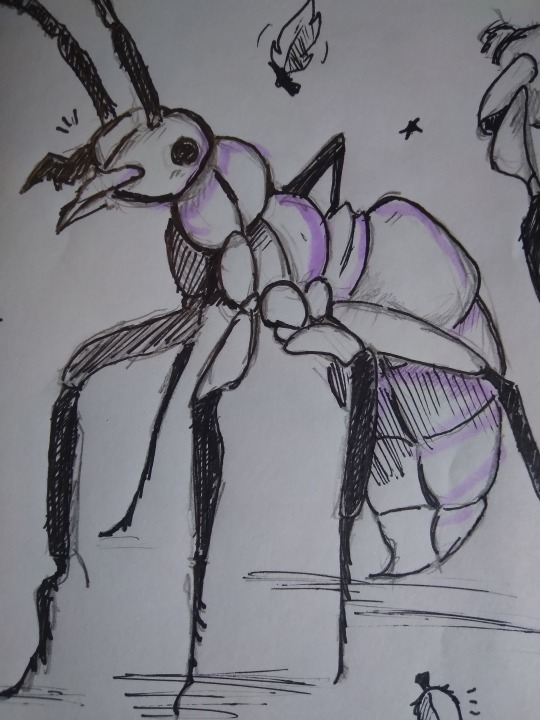
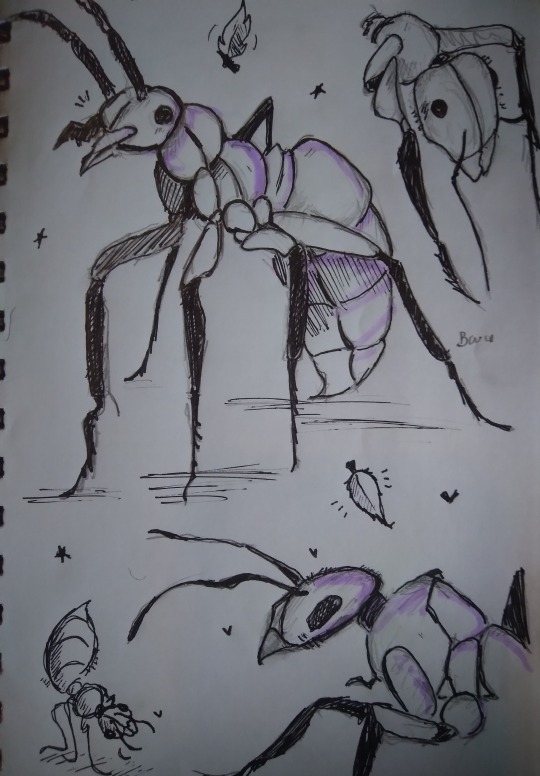
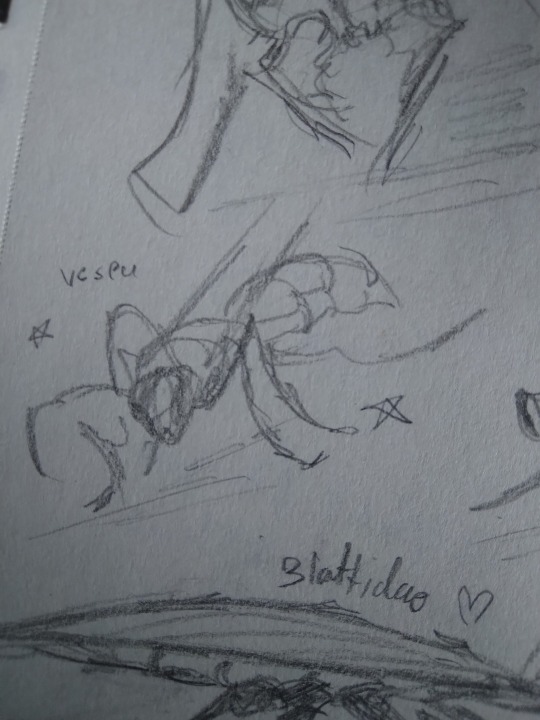
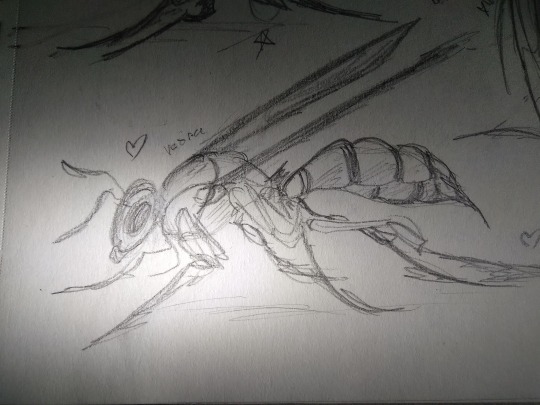
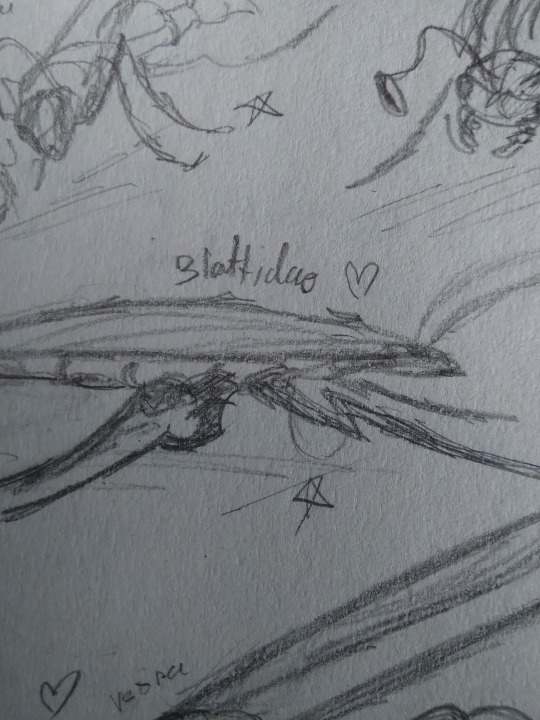
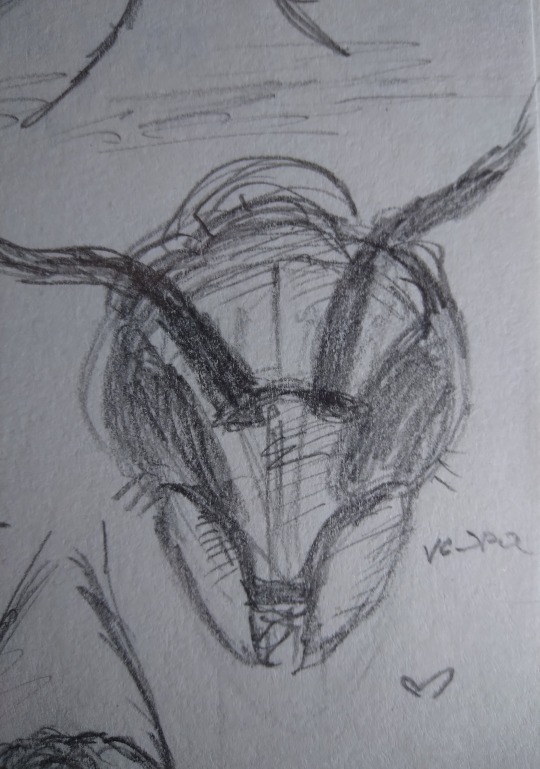

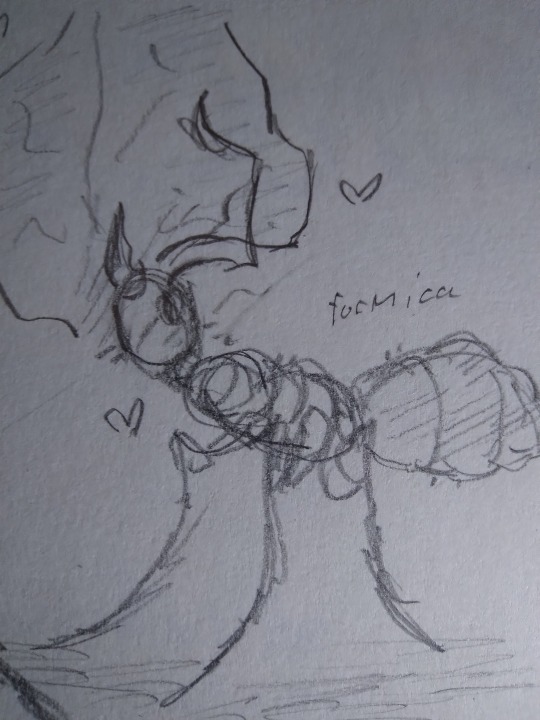
These included with also fictional bugs/ bug based characters and creatures that I drew all the time
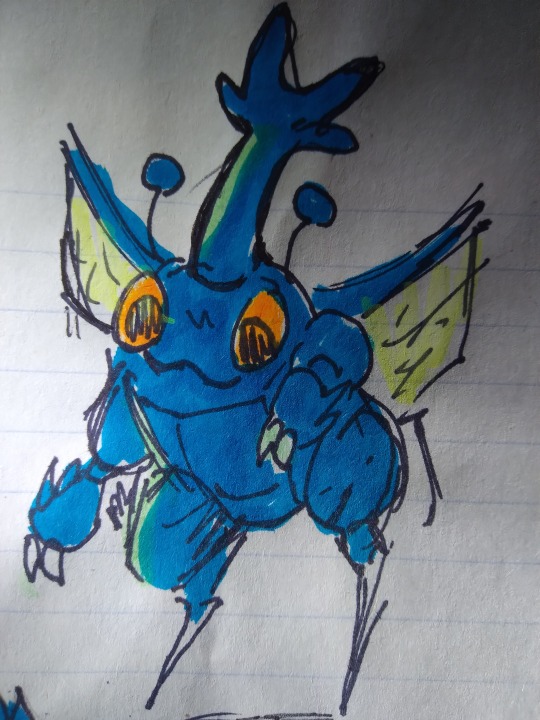
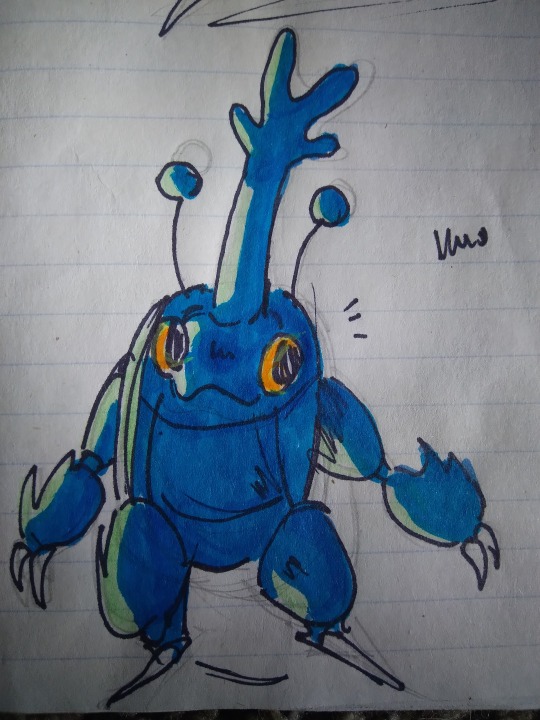

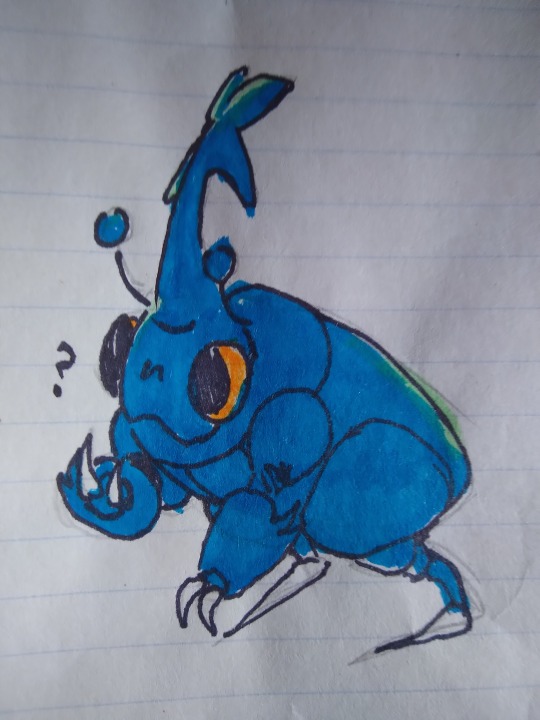
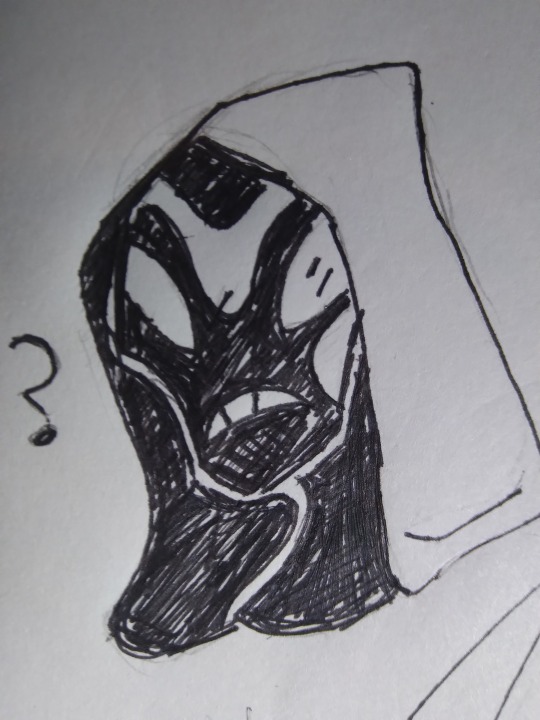
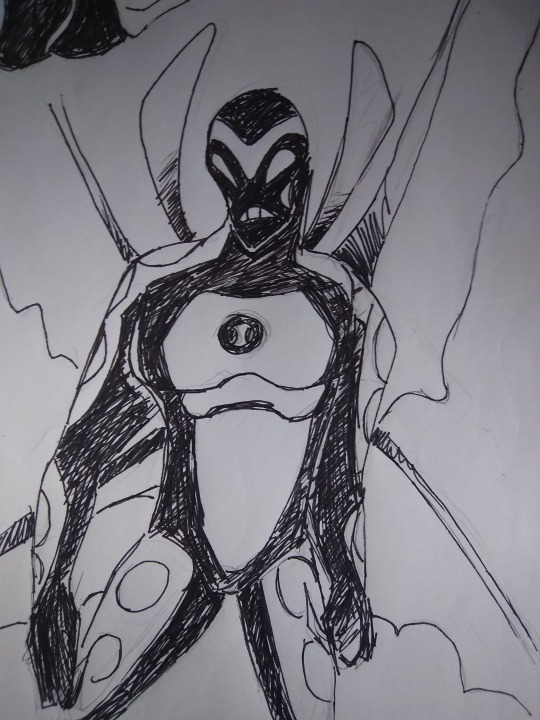
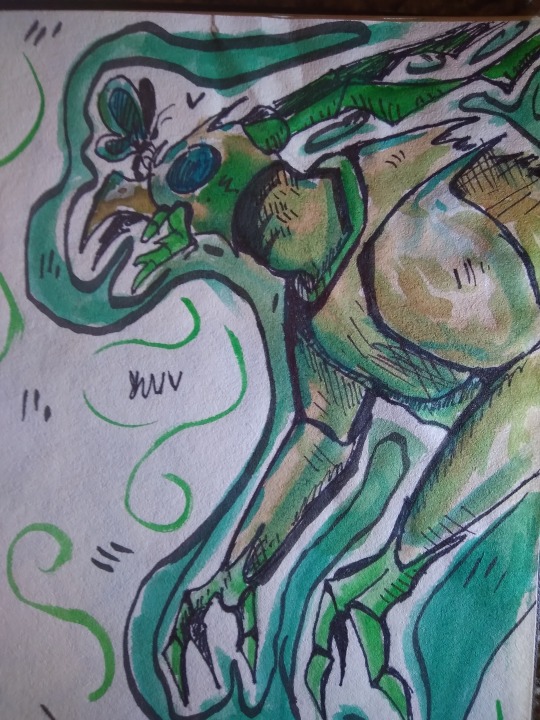
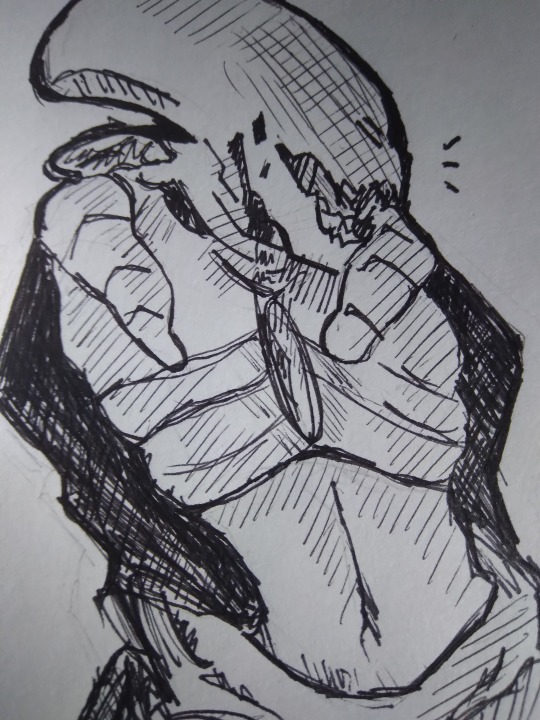

Like these don't even account for the multitudes of Scarab fanart I've made, simply because he's based off a beetle
#Like FUCK dude#It isn't just hyperfixating#Bugs have taken over my life LMAO#Nahh but the moment they're like “oh yeah we based the xenomorph off of different types of insects” they GOT me#ranting#personal rant#insects#ants#wasps
10 notes
·
View notes
Text
Life on our Planet has really reminded me why Walking with Dinosaurs is better than Walking with Monsters and why WWM desperately needed the extra three episodes that WWD and WWB got. While WWD did have that element of broad, sweep of history rise and fall of different groups elements going on, the focus in any episode was on a small group of animals just existing in their ecological context, they got to be both part of the story of life and organisms that lived, fed, bred and died. WWM, with it's lower episode count was forced to condense each section. which meant that animals were reduced purely to pokemon evolutions on their way to becoming modern animals.
In Walking with Dinosaurs, the animals kept on living after the credits rolled. In Walking with Monsters, what was on camera was all that existed. To it's credit, WWM tried to let the animals just be animals and do things other than murder each other, and the way the world felt much emptier worked in the section on the Permian mass extinction but the shortened run time to tell the history of life on earth forced it into this arthropods vs chrodates (then synapsids vs reptiles) narrative which lent itself much easier to a focus on predation than any other potential behaviours.
I have only watched the first episode and a half on Life on our planet and it seems to be doing a Walking with Monsters thing where's its subjects are primarily existing as evolutionary stepping stones on the way to modern animals as opposed to being allowed to be ecologically active in their own context. The cgi is better and thank fuck we finally seem to be getting feathered dromeosaurs as standard, but between that and the numerous inaccuracies that would be fine if it was the mid 2000s but aren't ok now.
Also that Smilodon/Titantis scene is some bollock mammal propaganda, I know titanis was capable of kicking the shit out of Smilodon.
(note: i haven't see walking with beasts so i am unable to factor them in as a comparison)
12 notes
·
View notes
Text
Archdevil: Arbeyach
The archdevils in the Tome of Beasts have a similar issue as the demon lords did. Translating these powerful beings across systems reaches the breaking points of the different rule sets, as the power scales are strange. In Pathfinder, typical archdevils should be on the deity scale and thus beyond anything the system can support, so most of them won't get any creature stat blocks, instead just being statted out as gods. For 13th Age though, the scene is much stranger than the demon lords. All the arch-devils should be above the power of the regular devils, but the 13th Age pit fiend is a huge level 14 foe, the top of the standard power scale for the system. Even a weakening arch-devil like Arbeyach should be stronger than the greatest standard devil, so to stat them out requires going beyond the system's usual cap, which is a huge deal and a lot of effort. And stronger arch-devils would go further beyond it, so I think that even in 13th Age many of the archdevils are too powerful for proper stat blocks. Overall, the arch-devils may get much smaller treatment than the demon lords did.
But Arbeyach, as a weakened archdevil, will get a full creature stat block in both. He's the weakest of the archdevils, but still an exceptionally dangerous threat, and so only pretty high level parties can be expected to face off against the Swarm Prince and survive.
Pathfinder 2e
Arbeyach is the lord of decay, taking the form of insect hives. Locusts and worms are his imagery, but he has a deeply rigid and ordered mind and imposes that onto his followers and the world around him. He is exceptionally inflexible, even among arch-devils, and builds his realm in the model of a great hive, every single creature within it obeying a specific function and built to best follow it.
He is truly ancient, having come into being from a great swarm of vermin created by Baalzebub to devour some of the first mortal souls to reach Hell. These vermin fused to the soul energy, becoming something greater. Arbeyach was a vassal of Baalzebub for eons, before rising up and becoming a proper Duke of Hell through his victories and power. Over the eons however, his ambitions shifted and his views became more rigid and unyielding, unable to respond to changes in the universe around him, and eventually he weakened and was stripped of his title. Now barely stronger than a pit fiend, he must either grow or surely face destruction at the hands of a rival.
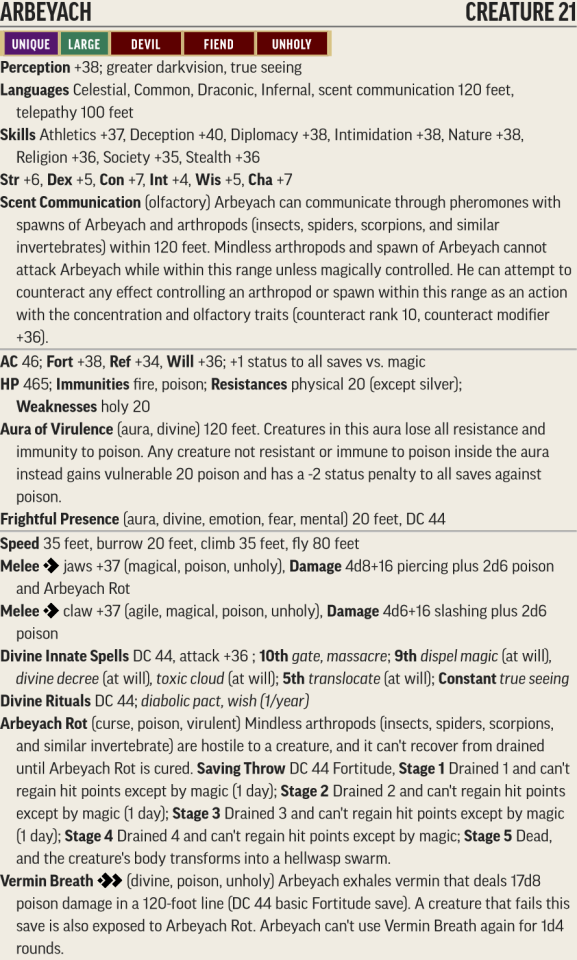
Arbeyach Creature 21
Unique, Large, Devil, Fiend, Unholy
Perception +38; greater darkvision, true seeing
Languages Celestial, Common, Draconic, Infernal, scent communication 120 feet, telepathy 100 feet
Skills Athletics +37, Deception +40, Diplomacy +38, Intimidation +38, Nature +38, Religion +36, Society +35, Stealth +36
Str +6, Dex +5, Con +7, Int +4, Wis +5, Cha +7
Scent Communication (olfactory) Arbeyach can communicate through pheromones with spawns of Arbeyach and arthropods (insects, spiders, scorpions, and similar invertebrates) within 120 feet. Mindless arthropods and spawn of Arbeyach cannot attack Arbeyach while within this range unless magically controlled. He can attempt to counteract any effect controlling an arthropod or spawn within this range as an action with the concentration and olfactory traits (counteract rank 10, counteract modifier +36).
AC 46; Fort +38, Ref +34, Will +36; +1 status to all saves vs. magic
HP 465; Immunities fire, poison; Resistances physical 20 (except silver); Weaknesses holy 20
Aura of Virulence (aura, divine) 120 feet. Creatures in this aura lose all resistance and immunity to poison. Any creature not resistant or immune to poison inside the aura instead gains vulnerable 20 poison and has a -2 status penalty to all saves against poison.
Frightful Presence (aura, divine, emotion, fear, mental) 20 feet, DC 44
Speed 35 feet, burrow 20 feet, climb 35 feet, fly 80 feet
Melee jaws +37 (magical, poison, unholy), Damage 4d8+16 piercing plus 2d6 poison and Arbeyach Rot
Melee claw +37 (agile, magical, poison, unholy), Damage 4d6+16 slashing plus 2d6 poison
Divine Innate Spells DC 44, attack +36 ; 10th gate, massacre; 9th dispel magic (at will), divine decree (at will), toxic cloud (at will); 5th translocate (at will); Constant true seeing
Divine Rituals DC 44; diabolic pact, wish (1/year)
Arbeyach Rot (curse, poison, virulent) Mindless arthropods (insects, spiders, scorpions, and similar invertebrate) are hostile to a creature, and it can't recover from drained until Arbeyach Rot is cured. Saving Throw DC 44 Fortitude, Stage 1 Drained 1 and can't regain hit points except by magic (1 day); Stage 2 Drained 2 and can't regain hit points except by magic (1 day); Stage 3 Drained 3 and can't regain hit points except by magic (1 day); Stage 4 Drained 4 and can't regain hit points except by magic; Stage 5 Dead, and the creature's body transforms into a hellwasp swarm.
Vermin Breath [2 actions] (divine, poison, unholy) Arbeyach exhales vermin that deals 17d8 poison damage in a 120-foot line (DC 44 basic Fortitude save). A creature that fails this save is also exposed to Arbeyach Rot. Arbeyach can't use Vermin Breath again for 1d4 rounds.
He still has some power from his time as a proper archdevil however, and is something of a god. While his followers are few and far between, as the Prince of Swarms cares little for mortals and their individual minds, some few can still find the power this former archdevil granted.
Areas of Concern decay, vermin
Edicts bring order and structure to existence in every way, eliminate disorder
Anathema undermine the hive, promote individuality
Divine Attribute Constitution (Arbeyach is inflexible, you do not have a choice)
Devotee Benefits
Cleric Spells 1st: ant haul, 3rd: insect form, 5th: subconscious suggestion
Divine Font heal
Divine Sanctification must choose unholy
Divine Skill Society
Domains cities, family, toil, tyranny
Favored Weapon spiked gauntlet
13th Age
Arbeyach is an exile from wherever the devils originated from. Apparently formerly some great power within the devil's structure, he now builds a great hive on the outer edge of the Dragon Empire, creating himself a new basin of power. He hates the disorder and chaos of the world, rigid and unyielding in his vision, and all he sees must conform to the structure and order of his ideal world. Few devils support him, lending more evidence to his lack of authority within their system, but some number seem to have been exiled with him and find a spot within his hive. His true goal is to turn the whole world into a single hive under his control, removing all individuality and conflict, but without the full structure of the devil hierarchy aiding him he must do it himself. Of course, with how powerful he is still, few could hope to stop him anyway.

Arbeyach
Large 15th level spoiler [devil]
Initiative: +21
Creature of Legend
Arbeyach can take two standard actions on each of his turns. He can’t use the same action twice on the same turn.
Curse Bite +20 vs. AC – 75 damage plus 50 ongoing poison damage.
Natural Even Hit: The target is also weakened as long as it’s taking the ongoing damage. A creature that dies while weakened this way bursts into an apocalypse swarm (see below).
Miss: 50 poison damage.
Diseased Claws +20 vs. AC (2 attacks) – 50 damage plus 20 poison damage.
Natural 14+: The target also takes 20 ongoing poison damage.
Contagion +20 vs. PD – Ongoing 75 poison damage and one of the following effects (determined at random): confused, stunned, vulnerable to all damage, weakened (save ends both).
C: Vermin Breath +20 vs. PD (1d4 nearby or far away enemies) – 85 poison damage and the target is hampered (save ends).
Natural Even Hit or Miss: An apocalypse swarm forms next to the target (see below).
Miss: 40 poison damage.
Limited Use: 3/battle, never two turns in a row.
C: Cloudkill +20 vs. PD (1d4+1 nearby enemies) – 50 poison damage.
Cloud: The cloud persists until the end of Arbeyach’s next turn. Any creature targeted by this attack takes 50 damage if it ends its turn without moving out of the cloud. At the start of each of Arbeyach’s turns, he can roll a normal save; on a success the cloud remains until the end of his next turn. If Arbeyach uses this attack while he has a cloud remaining from a previous casting, the previous cloud disappears.
Apocalypse Swarm: An apocalypse swarm spawns where indicated by the power that creates it, obeys Arbeyach’s orders, and enters initiative 10 points after Arbeyach. See apocalypse swarm stat blocks at the end of this entry.
Aura of Virulence: All attacks that deal poison damage made against nearby enemies are treated as if their natural attack roll was 5 points higher for the purpose of overcoming poison resistance. If the target doesn’t have poison resistance, the attack instead gains a +2 bonus to hit.
Burrower, Flyer, and Wall Crawler.
Devil’s Due (Grow Within): When you choose to add the escalation die to an attack against Arbeyach, he makes the following attack against you at the end of your turn as a free action. If you use the escalation die against him multiple times on the same turn, he does get to use this attack that many times.
[Special Trigger] They Grow Within +20 vs. PD – 80 damage and an apocalypse swarm bursts out of the target.
Miss: 20 damage.
Fear Aura: While engaged with Arbeyach, enemies that have 216 hp or fewer are dazed and do not add the escalation die to their attacks.
Resist Fire and Poison 18+.
AC 30 PD 30 MD 27 HP 1330
Level 14 Apocalypse Swarm
Swarm +19 vs. PD (1d3 nearby enemies) – 40 poison damage, and after the attack the swarm engages one of the targets.
Natural Even Hit: The target also takes 20 ongoing poison damage. If the target dies while taking this damage, another apocalypse swarm bursts from its corpse.
Flyer.
AC 30 PD 30 MD 23 HP 130
Inspired by the Tome of Beasts 1. This post came out a week ago on my Patreon. If you want to get access to all my monster conversions early, as well as access to my premade adventures and other material I’m working on, consider backing me there!
#pathfinder 2e#13th age#homebrew#my homebrew#monster#devil#fiend#pathfinder level 21#13th age level 15#long post#tome of beasts
4 notes
·
View notes
Text
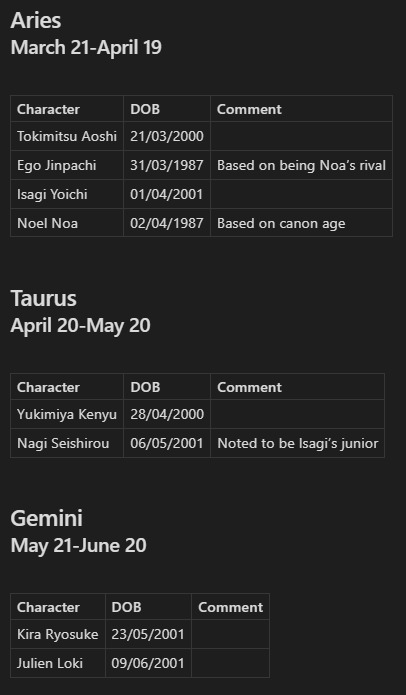
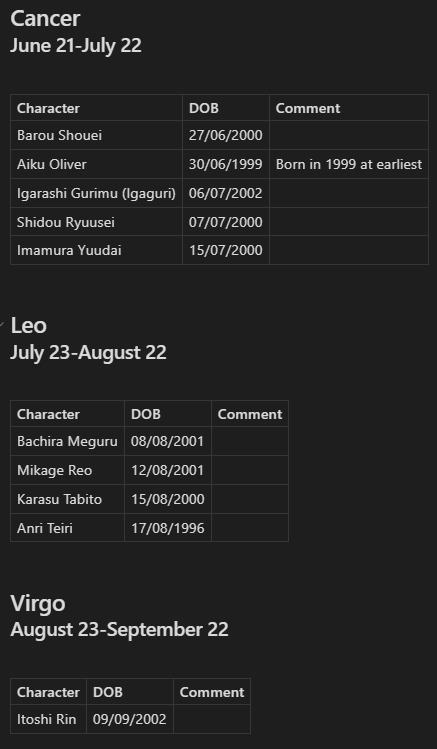
BL Characters and their DOB/Starsigns
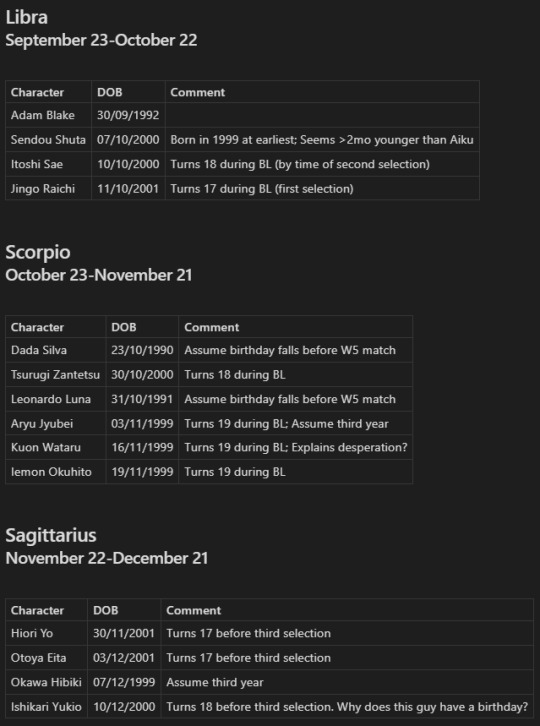
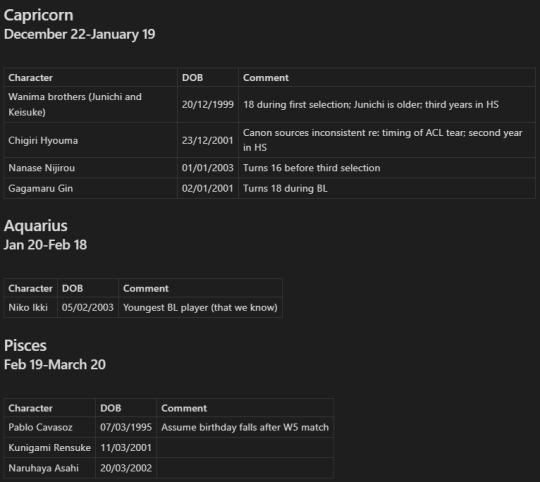
Sharing in case any other people with no lives fanfic writers might find this useful.
Most common starsign? A tie between classy Cancers and sexy Scorpios. Arthropod gang, rise up 🦀 🦂🦀 🦂🦀 🦂
As for least common, Niko's the only Aquarius so far. After that, it's Geminis, repped by unlikely twins Kira and Loki.
As a reference, this database is absolutely useless in image format. Here's a pastebin link to the Markdown source. Use ctrl+f to search by name, month or starsign. I update it sporadically whenever new DOBs are revealed.
Do as you will with this, but appreciate credit if you decide to repost it or whatever.
Suggested reading: A Tentative Timeline for Blue Lock by blue-lock-rocky/echari3
Updates since original post: Nishioka, Lorenzo and Kurona's birthdays added
#blue lock#blue lock manga#bllk manga#blue lock analysis#bllk analysis#reference#bllk reference#blue lock birthdays#bllk birthday#birthday#star signs#mine#boinin talks bllk
28 notes
·
View notes